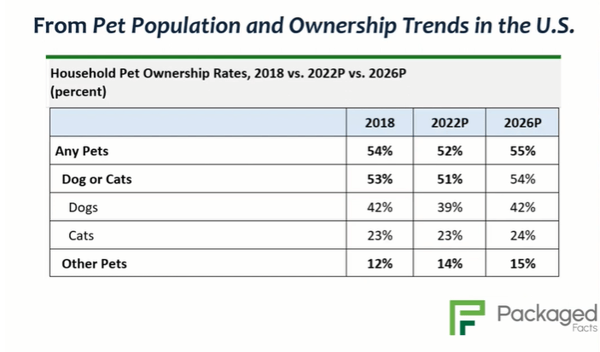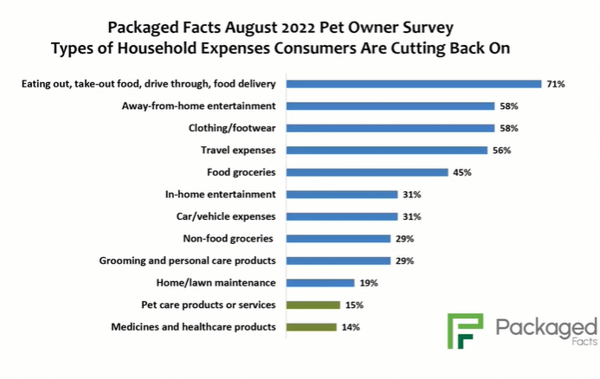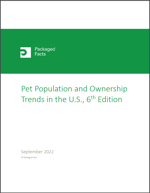Pet Ownership Trends and the U.S. Pet Market Outlook
To predict where the U.S. pet industry is headed next, it’s crucial to understand current pet population and ownership trends and put them in context.

Long-time Packaged Facts analysts David Sprinkle and David Lummis authored the newly published report Pet Population and Ownership Trends in the U.S., 6th Edition, which provides comprehensive and up-to-date analysis of pet ownership rates, population characteristics, and pet owner demographics. In a recent video interview, these two analysts sat down to share a few of the most interesting findings from the report. Watch a video of their discussion or read a brief recap below to learn how pet ownership is shifting in the U.S. and what this means for future pet market opportunities. David Sprinkle explained that COVID had a mixed impact on the U.S. pet population. Pet adoption jumped among more prosperous households and employees working from home, which led to notable sales gains in the pet market. However, lower-income and more budget-conscious households cut back on pet ownership during the same period. Another noteworthy shift was an incremental 3 percent decline in dog ownership between 2018 and 2022. Dogs are the most popular type of pet, but they are also the most expensive, the hardest to keep, and the most dependent on housing type. Because dogs are such a huge part of the overall pet market, this decline could be especially significant. New headwinds could also hamper pet population growth, including the high level of inflation and soaring mortgage rates, which dampen household formation—a prime occasion for adopting new pets, particularly dogs. In addition, specific generational patterns are also expected to serve as restraining factors. As people reach retirement age, they tend to cut back on pet ownership due to their living environment and the work involved in pet ownership. Although baby boomers held onto their pets longer than we’ve seen in previous generations, now more boomers are aging out of pet ownership. Pets are increasingly popular among Gen Z, but overall, younger generations are not filling in the gap created by aging baby boomers. While the pet industry faces some challenges, the deep affection Americans feel for their pets will keep them spending almost no matter what. Pets are considered an integral part of the household, and the “pets as family” mindset is essentially stable across generations. This mentality helps drive increased spending across many different categories, including pet food, veterinary services, non-food supplies, and non-medical services such as grooming and boarding. What’s more, pet spending tends to be extremely sticky. Packaged Facts surveys show that a majority of U.S. households are planning to cut back on expenses such as eating out, travel expenses, or clothing purchases. However, pet care products or services and medical expenses are two of the household categories consumers are the least likely to cut back on. People believe pets are important to their own physical and mental health, and they are committed to keeping their pets healthy and happy as well. The more people treat their pets as family, the more they are willing to spend on them, particularly for products and services that are seen as health related. Because pet products and services are considered essential, the pet industry has strong prospects for the future and a well-deserved reputation for being recession resilient. Download a free sample and read the full table of contents to learn more about this valuable resource. Packaged Facts, a division of MarketResearch.com, publishes market intelligence on a wide range of consumer market topics, including consumer demographics and shopper insights, the food and beverage market, consumer financial products and services, consumer goods and retailing, and pet products and services. Packaged Facts also offers a full range of custom research services. Reports can be purchased at our company website and are also available through MarketResearch.com. To predict where the U.S. pet industry is headed next, it’s crucial to understand current pet population and ownership trends and put them in context. To access this type of data and analysis, there is no better resource to turn to than Packaged Facts, a leading market research firm that has been closely following the U.S. pet market for decades.
To predict where the U.S. pet industry is headed next, it’s crucial to understand current pet population and ownership trends and put them in context. To access this type of data and analysis, there is no better resource to turn to than Packaged Facts, a leading market research firm that has been closely following the U.S. pet market for decades.U.S. Pet Population Growth Relatively Flat

Recent Economic and Demographic Challenges
Pet Industry Sales Growth Remains Bullish

Where to Learn More
 The data cited in this video discussion is drawn from the recent report Pet Population and Ownership Trends in the U.S., 6th Edition by Packaged Facts, which provides comprehensive and up-to-date analysis of pet ownership rates, population characteristics, and pet owner demographics. This report focuses on dogs and cats but also provides topline coverage of ownership rates for other types of pets such as fish, small mammals, herptiles, and birds.
The data cited in this video discussion is drawn from the recent report Pet Population and Ownership Trends in the U.S., 6th Edition by Packaged Facts, which provides comprehensive and up-to-date analysis of pet ownership rates, population characteristics, and pet owner demographics. This report focuses on dogs and cats but also provides topline coverage of ownership rates for other types of pets such as fish, small mammals, herptiles, and birds.About Packaged Facts

 Troov
Troov 









![What Are Local Citations [+ 4 Steps to Build Them for Your Business]](https://blog.hubspot.com/hubfs/GettyImages-1331173398%20%281%29%20%281%29.jpg#keepProtocol)


![8 Data-Backed Recommendations for Social Media Marketers in 2022 [Insights from 300+ Professionals]](https://blog.hubspot.com/hubfs/a%20consumer%20looks%20at%20a%20social%20media%20marketing%20campaign%20on%20their%20smartphone.jpg#keepProtocol)



















.jpg&h=630&w=1200&q=100&v=f776164e2b&c=1)